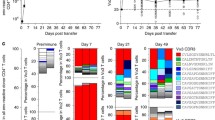Abstract
The role of the A and E molecules as restriction elements was examined in the F antigen system. In the mouse the only responder haplotype known to date isk, and blocking studies with a monoclonal antibody show that in vitro T-cell proliferation is restricted by the Ak molecule. The (CBA × DBA/2) F1 hybrid, which is a responder x nonresponder cross, is itself a nonresponder in terms of E-specific antibody production. Up to 10 days after priming, (CBA × DBA/2) F1 T cells exhibited an E-specific proliferative response, but this diminished rapidly at later times. This diminution could be blocked with an E-specific monoclonal antibody, suggesting that suppression is restricted by the E molecule.
Similar content being viewed by others
References
Araneo, B. A., Yowell, R. L., and Sercarz, E. E.: Ir gene defects may reflect a regulatory imbalance. I. Helper T cell activity revealed in a strain whose lack of response is controlled by suppression.J. Immunol. 123: 961–967, 1979
Baxevanis, C. N., Ishii, N., Nagy, Z. A., and Klein, J.: Role of the Ek molecule in the generation of suppressor T cells in response to LDHB.Scand. J. Immunol. 16: 25–31, 1982
Debré, P., Kapp, J. A., and Benacerraf, B.: Genetic control of specific immune suppression. II. H-2-linked dominant genetic control of immune suppression by the random copolymer L-glutamic acid50-L-tyrosine50 (GT).J. Exp. Med. 142: 1447–1454, 1975
Dialynas, D. P., Wilde, D. B., Marrack, P., Pierres, A., Wall, K. A., Havran, W., Otten, G., Loken, M. R., Pierres, M., Kappler, J., and Fitch, F. W.: Characterisation of the murine antigenic determinant, designated L3T4a, recognised by monoclonal antibody GK-1.5: Expression of L3T4a by functional T cell clones appears to correlate primarily with class II MHC antigen-reactivity.Immunol. Rev. 74: 29–56, 1983
Iscove, N. N. and Melchers, F.: Complete replacement of serum by albumin, transferrin, and soybean lipid in cultures of lipopolysaccharide-reactive B lymphocytes.J. Exp. Med. 147: 923–933, 1978
Ishii, N., Baxevanis, C. N., Nagy, Z. A., and Klein, J.: Selection of H-2 molecules for the context of antigen recognition by T lymphocytes.Immunogenetics 14: 283–292, 1981
Klein, J., Nagy, Z. A., Baxevanis, C. N., and Ikezawa, Z.: The major histocompatibility complex and the specificity of suppressor T lymphocytes.In Y. Yamamura and T. Tada (eds.):Progress in Immunology V. Fifth International Congress of Immunology, pp. 935–947, Academic Press, London, 1983
Long, G. W., Bernard, C. C. A., Mackay, I. R., Wittingham, S., and Bhattal, P. S.: Localization of genetic control in mice over response to liver-specific F antigen.Tissue Antigens 11: 45–49, 1978
Lukic, M. L. and Mitchison, N. A.: Self- and allo-specific suppressor T cells evoked by intravenous injection of F protein.Eur. J. Immunol. 14: 766–768, 1984
Nagy, Z. A., Baxevanis, C. N., Ishii, N., and Klein, J.: Ia antigens as restriction molecules in Ir-gene controlled T-cell proliferation.Immunol. Rev. 60: 59–83, 1981
Nagy, Z. A., Baxevanis, C. N., and Klein, J.: Cross-reactivity of suppressor T cells specific for lactate dehydrogenase B and IgG2a myeloma protein.J. Immunol. 130: 1498–1499, 1983
Nardi, N. B.: Genetics and tolerance in the F antigen system, PhD thesis; University of London, 1984a
Nardi, N. B.: Role of suppressor cells in non-MHC-linked genetic control of the antibody response to F antigen.Braz. J. Genet., in press, 1984b
Ozato, K., Mayer, N., and Sachs, D. H.: Hybridoma cell lines secreting monoclonal antibodies to mouse H-2 and Ia antigens.J. Immunol. 124: 533–540, 1980
Pierres, M., Devaux, C., Dasseto, M., and Marchetto, S.: Clonal analysis of B- and T-cell responses to la antigens. I. Topology of epitope regions on I-Ak and I-Ek molecules analyzed with 35 monoclonal alloantibodies.Immunogenetics 14: 481–495, 1981
Sasazuki, T., Nishimura, Y., and Muto, M.: MHC-linked immune suppression genes and antigen-specific suppressor T cells in man.In Y. Yamamura and T. Tada (eds.):Progress in Immunology V. Fifth International Congress of Immunology, pp. 949–958, Academic Press, London, 1983
Silver, D. M. and Lane, D. P.: Dominant nonresponsiveness in the induction of autoimmunity to liver-specific F antigen.J. Exp. Med. 142: 1455–1461, 1975
Silver, D. M. and Lane, D. P.: Identification of the gene locus controlling dominant nonresponsiveness to F antigen.Immunogenetics 4: 295–299, 1977
Silver, D. M. and Lane, D. P.: Polygenic control of the immune response to F antigen.Immunogenetics 12: 237–251, 1981
Sunshine, G. H., Cyrus, M., and Winchester, G.:In vitro responses to the liver antigen F.Immunology 45: 357–363, 1982
Wedderburn, L., Lukic, M. L., Edwards, S., Kahan, M. C., Nardi, N., and Mitchison, N. A.: Single-step immunosorbent preparation of E-protein from mouse liver with conservation of the allo-antigenic site, and determination of concentration in liver and serum.Mol. Immunol. 21: 979–984, 1984
Author information
Authors and Affiliations
Rights and permissions
About this article
Cite this article
Oliveira, D.B.G., Blackwell, N., Virchis, A.E. et al. T helper and T suppressor cells are restricted by the A and E molecules, respectively, in the F antigen system. Immunogenetics 22, 169–175 (1985). https://doi.org/10.1007/BF00563514
Received:
Issue Date:
DOI: https://doi.org/10.1007/BF00563514




